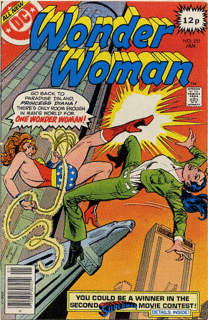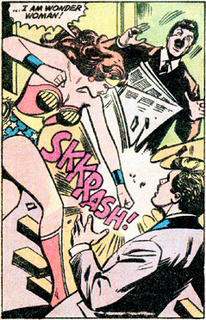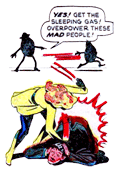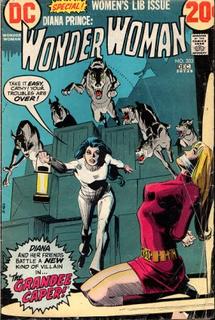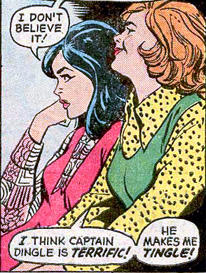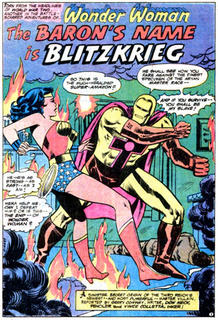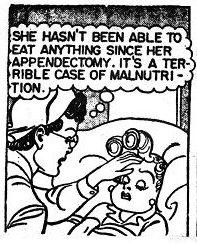We now get to a story so big and stupid that it's going to take an entry all its own.
 Jack C. Harris continues to demonstrate how he can beat about the bush with the wrong end of the stick in #252 as Wonder Woman commences her astronaut training (1). Cue the appearance of Astarte, Empress of the Silver Snake, mysterious gold skinned bimbo in a space bikini who is harassing passing space capsules. Luckily it's Wonder Woman she is after, so it's handy that WW has just become an unofficial support service for the space program. But first we have to meet Wonder Woman's new supporting cast, though there's no need to remember their names; they won't be around for long.
Jack C. Harris continues to demonstrate how he can beat about the bush with the wrong end of the stick in #252 as Wonder Woman commences her astronaut training (1). Cue the appearance of Astarte, Empress of the Silver Snake, mysterious gold skinned bimbo in a space bikini who is harassing passing space capsules. Luckily it's Wonder Woman she is after, so it's handy that WW has just become an unofficial support service for the space program. But first we have to meet Wonder Woman's new supporting cast, though there's no need to remember their names; they won't be around for long.Once Wondy arrives Astarte claims she is evil, and so they have a big fight in space. But when Astarte sees Wonder Woman rescue the space shuttle that had got a bit squashed earlier in the story, she gets confused and turns into a lead statue (2). Harris's real gem for this issue is having the fight start in Earth orbit and then finish up on the Moon without any appreciable distance covered. Theoretically we could have missed the bit of the fight where WW gets slugged 220,000 miles, but if that's the case, why is the space shuttle still floating nearby when the catfight can't have affected it? And why is the villain named Astarte anyway?
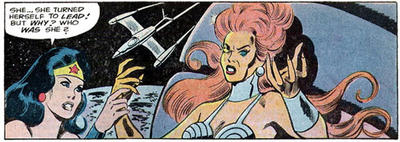
There is a cutaway scene with Queen Hippolyte biting her fingernails worrying that the gods will wreak some terrible revenge on Diana for leaving the island without permission(3), and she will be particularly vulnerable because the gods are so much more powerful in space (4), but even so they would have to be working in a particularly oblique and mysterious way to employ a goddess from a whole different pantheon to do so (5).
Issue #253 opens with the big snake shaped space ship of Astarte being examined by amazons on the Moon. Wonder Woman has called them in for no obvious reason (6) to tow it away or something. She says to her mother "This lead statue was alive just an hour ago -- A creature of silver and gold..! When she changed to lead, I realised some kind of magic must be involved..." Way to spot the obvious, Princess.
She then explains how she repaired the space shuttle that had got a bit squashed in the fight (7) "And with only 1/6th of Earth's gravity, my amazonian super-strength was multiplied -- allowing me to hurl it back into space towards Earth."(8)(9)
 Astarte then wakes up and goes for Hippolyte's throat. The amazon technicians, all dressed in battle bikinis, attack with rayguns but are knocked backwards by the recoil due to the low gravity(10) and have to resort to swords instead(11). She then retreats, even though the swords are clearly not hurting her(12), saying "You have made an enemy of me this day, Hippolyte -- and my vengence shall be devastating!" Which is a bit rich, since it was she who started the fight. She flies off in her snake ship but Hippolyte refuses to pursue her, on the basis that she seems familiar and she wants to check the amazon database in case it has anything on strange gold empresses who drive giant snake spaceships that might have slipped her mind.
Astarte then wakes up and goes for Hippolyte's throat. The amazon technicians, all dressed in battle bikinis, attack with rayguns but are knocked backwards by the recoil due to the low gravity(10) and have to resort to swords instead(11). She then retreats, even though the swords are clearly not hurting her(12), saying "You have made an enemy of me this day, Hippolyte -- and my vengence shall be devastating!" Which is a bit rich, since it was she who started the fight. She flies off in her snake ship but Hippolyte refuses to pursue her, on the basis that she seems familiar and she wants to check the amazon database in case it has anything on strange gold empresses who drive giant snake spaceships that might have slipped her mind.So Wonder Woman decides it's time to get back to her day job where the astronaut trainees are practicing for the lack of gravity in space in NASA's Weightlessness Chamber(13). And then while Diana Prince slips into soap opera mode, pining for dead Steve Trevor and then snogging the nearest hunk for no good reason and then agonising about it, Astarte is watching from a rock on the far side of the Moon(14). And yet despite her phenomenal eyesight, when she shoots a beam at Diana, it misses her by several feet and causes the G-force simulator to come loose, which is irritating as Diana seems to believe that the simulator could go up to "several hundred times the force of Earth's gravity" and I was looking forward to seeing the pilot being turned to jam when they cranked it up (15). Diana catches the rogue simulator and pauses only to have another page of angst before jumping into her robot plane and heading into space again.
 Tracking Astarte by the radiation residue of her eye-beams (16), she meets up with a squadron of amazon fighters that hardly look like X-wings at all, honest, and then they all jump out of their fighter planes to attack Astarte on foot with swords(17). Astarte immediately beats them by fusing their bracelets together, which takes all their strength away, or destroying their bracelets, which makes them foam at the mouth. She then steals Hippolyte's magic girdle which causes them to lose all the powers they hadn't already lost when she stuck their bracelets together. Meanwhile Wonder Woman has cleverly spotted that she knows all their weaknesses and asks her mother if she has worked out who this odd creature is.
Tracking Astarte by the radiation residue of her eye-beams (16), she meets up with a squadron of amazon fighters that hardly look like X-wings at all, honest, and then they all jump out of their fighter planes to attack Astarte on foot with swords(17). Astarte immediately beats them by fusing their bracelets together, which takes all their strength away, or destroying their bracelets, which makes them foam at the mouth. She then steals Hippolyte's magic girdle which causes them to lose all the powers they hadn't already lost when she stuck their bracelets together. Meanwhile Wonder Woman has cleverly spotted that she knows all their weaknesses and asks her mother if she has worked out who this odd creature is.And in fact it seems that Hippolyte has deduced that it is her dead sister, Diana, who had been killed by Hercules in the Tales of the Amazons story in WW #247 even though she looks nothing like her and has, after all, been dead for at least a millenium. Perhaps the snake fetish gave her away.
 Astarte/Diana then relates how she watched the amazons build their society on Paradise Island in disembodied form but then grew weak and so flew out amongst the stars until she was attracted to a strange silver and gold asteroid. For no explained reason she is able to form a new body from this asteroid as well as create a spaceship shaped like a big snake. Returning to Earth, she finds that she is weakened if she gets too close to the planet, but luckily she has acquired such good eyesight now that she notices Wonder Woman beating up some guys from orbit, but assumes that WW is her own body inhabited my some evil spirit and so picks a fight with her. She never does explain why she calls herself by the name of a goddess from another pantheon, or what the whole "empress of the silver snake" thing was about, or even where she learned how to build a spaceship.
Astarte/Diana then relates how she watched the amazons build their society on Paradise Island in disembodied form but then grew weak and so flew out amongst the stars until she was attracted to a strange silver and gold asteroid. For no explained reason she is able to form a new body from this asteroid as well as create a spaceship shaped like a big snake. Returning to Earth, she finds that she is weakened if she gets too close to the planet, but luckily she has acquired such good eyesight now that she notices Wonder Woman beating up some guys from orbit, but assumes that WW is her own body inhabited my some evil spirit and so picks a fight with her. She never does explain why she calls herself by the name of a goddess from another pantheon, or what the whole "empress of the silver snake" thing was about, or even where she learned how to build a spaceship.Apparently Hippo has never mentioned that she had a sister to her daughter, even though she not only named her Diana in honour of her fallen sibling, but apparently fashioned her to look exactly the same(18). Seems a bit remiss of her. Hippo then points out that Astarte/Diana is dead, which comes as a bit of a shock to her(19) and her body crumbles. Aphrodite and Athena then pop up, presumably to make sure she doesn't get lost on her way to Tartarus this time, and Wonder Woman is left to ponder the infinite. And possibly why her mother is so secretive about the most unlikely things.
So what makes this story so terminally awful? Is it the deliberate effort made to insert factual information into the script and yet get it so horribly, horribly wrong? Is it the blatent plot devices that have no other purpose but to move the story along? The complete failure to explain anything that happens to Astarte from her death onwards? Hippolyte's curiously secretive "tribute" to her dead sister? A combination of all of this, probably. Though the fun with physics has to be a major factor.
Notes
1. which requires her to have a degree in maths, science, or engineering and logged 1,000 hours of flight time. Apparently she is also required to have excellent vision, which makes you wonder why no one has asked why she is wearing glasses.
2. you can only get this from the text as the colourist has failed to spot that Astarte should have changed colour at this point and she remains coloured gold for the rest of the issue (see pic above).
3. In issue #251. Not that it's any business of theirs anyway.
4. What the?
5. Astarte is the goddess of love, sometimes the goddess of love and war of the Phoenicians. She would be the equivalent of Aphrodite (ie. the Amazons' patron) from the greek pantheon.
6. It does make a certain amount of sense to have the amazons check it out for her, but since she never does this in any other story it's a bit of a blatent plot device.
7. One assumes that robot plane of hers must carry a good invisible toolkit.
8. I'm no physics geek but even I know the difference between weight and mass, and lower gravity would have made no difference to how much strength would have been required to throw it.
9. So Wonder Woman has just lobbed the space shuttle in the general direction of Earth from the Moon and assumes it will be fine, even though it was only intended to fly in Earth orbit and would not have had the fuel or the engines to deal with the situation. Hard to believe anyone writing about the space program during the 1970's could be so ignorant. Did Harris sleep through Apollo 13 or something?
10. What kind of raygun has recoil? Light beams do not have mass and so cannot cause recoil. Why include this kind of physics detail and get it so completely wrong?
11. They can't compensate for the recoil on a raygun but they are okay with swinging a heavy lump of metal around in 1/6th gravity? Amazon training seems a bit overly selective if you ask me.
12. It could happen.
13.One panel actually shows a sword going into her torso and poking out the other side, but this doesn't seem to bother her.
14. I'm sure NASA would love to have such a device but actually it's a little more difficult to simulate weightlessness. In fact the best NASA has managed so far is to take astronauts up in a big aircraft really high and then let it go into freefall, which gives about 30 seconds of weightlessness.
15. One panel shows the Moon between Astarte's rock and the Earth. She must have exceedingly good eyesight to not only see things more than 239,000 miles away, but through that much solid matter as well.
16. Fighter pilots are able to take around 8G on high speed turns before blacking out due to the blood being forced toward their extremeties and away from their brain. 200G would likely crush you to a thin smear of jelly.
17. Huh?
18. So when Hippo sculpted her as a baby from clay she did so with a clear idea of what she would look like as an adult?
19. It never occured to her all the time she was floating around as a ghost?








